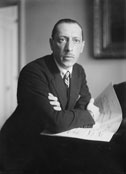|
After literature, music was the next Russian cultural export to gain
considerable renown in the West. During the 25 years before Diaghilev began to be active
in Paris, a number of operatic and symphonic works by the so-called Mighty Handful of
composers--Rimsky-Korsakov, Borodin, Mussorgsky, Cui and Serov--had had their French premieres.
Diaghilev's first concerts abroad took place within the galleries of the 1906 exhibit of Russian painting
and sculpture that he organized within the Salon d'Automne. The next year he moved on to
larger-scale symphonic performances, and in 1908 he was responsible for the first production
on a Parisian stage of Mussorgsky's classic opera Boris Godunov. The opera's star was
the legendary bass singer Feodor Chaliapin, who made his Paris debut to sensational acclaim
and established a reputation as one of the greatest basses in history.
Diaghilev's ballet seasons, which began in 1909, also at first featured mainly
Russian composers and Russian performers. The works of the Mighty Handful and
other composers were adapted and abridged to suit the choreographic needs of the
choreographer Mikhail Fokin and his successors. Among these pieces were Rimsky-
Korsakov's Scheherezade suite, and the Polovetsian Dances from Borodin's opera
Prince Igor. Diaghilev also featured the next generation of Russian
composers, including Nikolai Tcherepnin, whose Le Pavillon D'Armide was the
very first ballet performed by the company, and who conducted the orchestra for
the first several seasons. A student of both Rimsky-Korsakov and Tcherepnin,
Igor Stravinsky had his international career launched by Diaghilev, and would
become the musician most identified with the Ballets Russes. Between 1910 and
1929 Stravinsky created six ballets, two opera-ballets and an opera for Diaghilev,
including such masterworks as Petrushka, The Rite of Spring, Fire bird, Pulcinella, and Apollon Musagète.
Serge Prokofiev, yet another student of Tcherepnin, also composed for Diaghilev,
creating three ballets-Chout, Le Pas d'Acier, and Le Fils Prodigue.
While the 1909-1916 seasons could rightly be described as the Russian years of
the Ballets Russes, after 1917, Diaghilev turned increasingly to French and other
European composers. Even before that point, he produced ballets by Maurice Ravel
and Claude Debussy, and later the Ballets Russes repertoire included compositions
by Erik Satie, Manuel de Falla, Francis Poulenc and others.
|


Igor Stravinsky
|